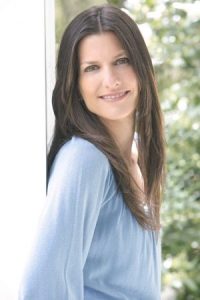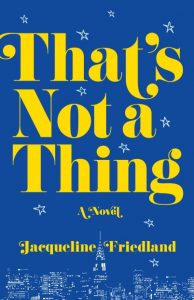Genre Hopping
 I am a genre hopper. There. I said it.
I am a genre hopper. There. I said it.
My first novel, Trouble the Water, is historical fiction, and my second, That’s Not a Thing, is contemporary. People keep asking me how this can be, how one author can inhabit two different spheres?
But isn’t this the story of what we, as women, do so often? When one thinks about the number of divergent domains adult women are asked to inhabit on a regular basis, it’s rather exhausting. We are daughters, and mothers, wives, and sisters. We are workplace professionals and at-home caregivers. In our careers, we are expected to be assertive and strong (“never ever cry at work”) but also kinder and gentler than our male counterparts (“I’d never expect that kind of pushy attitude coming from you”).
As caregivers, we can be asked to function as teacher, chef, personal assistant, chauffeur, doctor, event planner, hair stylist, and more. We learn to perform effectively in myriad roles, often by honing our skills of compartmentalization. It’s all about time and place, right?
Choosing a genre of fiction really comes down to time and place, as well. There isn’t all that much difference in the range of human sentiments that are possible across time, location, or even dimension. Whether you’re writing a novel that takes place in China during the 1700s or a story based in LA in 2020, the spectrum of human emotions that would be possible to portray is still largely constant. Falling in love causes the same adrenaline rush, the same weakening of the knees, whether it’s being described in old English or a cutting-edge Gen Z vernacular. Either way, it’s totally lit.
Writing That’s Not a Thing, contemporary women’s fiction, was all about tapping into the emotions of my characters. The story features a young woman who is torn between two great loves from different periods of her life. This is a premise that could easily be transplanted to different time periods or locations without taking anything away from the deep and complicated emotions the characters must muddle through before the story’s end. What I didn’t realize before I wrote the novel was that just as I was compartmentalizing by choosing one time period over another, so too were my characters compartmentalizing.
My main character, Meredith Altman, a young attorney in Manhattan, constantly attempts to keep her focus on certain aspects of her life while blocking out others. When she is in college and her mother is sick with breast cancer, Meredith feels she must be both a doting daughter focused on her mother’s treatment, and also a fun college co-ed who drinks and dates and doesn’t bring down her friends by continually lamenting her mother’s health.
Later, as an attorney, Meredith struggles between the large corporate cases that are the lifeblood of her firm’s economic health and the pro bono work that she prefers to pursue. At the story’s core is also Meredith’s struggle between Wesley, her first great love, and Aaron, her doting fiancé. She is invariably donning different hats depending on who else is in the room, and she struggles to determine just which hat fits her best.
Like Meredith, I once wondered whether one writing hat fits me better than another. There are many ways in which writing contemporary fiction is easier than writing historical. You needn’t spend countless hours researching menus and food preparation before your characters can sit down for a simple meal. If you have a medical question, you can pick up the telephone or turn to your computer to learn about current treatments for particular ailments.
On the flip side, when you’re writing contemporary fiction, you are describing locations and situations that are familiar to your readers. Two people can see the same skyscraper from completely different perspectives. When you’re describing the Chrysler building, it has to look right to both of those readers, a task which presents a whole new set of challenges. Moreover, without the distraction of the changed historical setting, the interior lives of the characters can move even closer to the forefront of your readers’ focus, so those depictions had better be spot-on.
I’ve so greatly enjoyed writing both historical and contemporary fiction that I would be loath to commit to one genre over the other. I am most comfortable when I have the freedom to change hats regularly. I mean, one hat? Yeesh. As someone who likes to change shoes as often as I change my roles at home, exploring different genres feels not only natural, but necessary. At the end of the day, these different hats should all qualify as thinking caps, which might be a writer’s most important hat of all.
Many of us often read across genres. If a story is well-told, it doesn’t matter so much whether it’s contemporary fiction, historical fiction, romantic fiction, sci-fi or fantasy. We want to feel love and excitement along with the characters, to understand their motivations, their suffering and joy. The important point is to connect with the story and the emotions therein. As far as time and place, it’s a pleasure to realize the consistencies that are part of being human, where ever we are. So, come, hop genres with me.
—
Jacqueline Friedland is the award-winning author of Trouble the Water, a historical fiction novel. Her contemporary women’s fiction debut, That’s Not a Thing, is forthcoming in April 2020.
Jacqueline graduated Magna Cum Laude from both the University of Pennsylvania and NYU Law School. She practiced as a commercial litigator at the New York law firms of Debevoise & Plimpton, LLP and Boies, Schiller & Flexner, LLP. After determining that office life did not suit her, Jacqueline began teaching Legal Writing and Lawyering Skills at the Benjamin Cardozo School of Law in Manhattan and working on her first book in her limited spare time. Finally deciding to embrace her passion and pursue writing full time, Jacqueline returned to school to earn her Masters of Fine Arts from Sarah Lawrence College, graduating from the program in 2016.
When not writing, Jacqueline is an avid reader of all things fiction. She loves to exercise, watch movies with her family, listen to music, make lists, and dream about exotic vacations. She lives in Westchester, New York with her husband, four children and two very bossy canines.
That’s Not A Thing
 Meredith Altman’s engagement to Wesley Latner ended in spectacular disaster. When Wesley lost his parents in an accident, mere weeks before the wedding date, he blamed Meredith and left for an open-ended journey to Europe, breaking off their engagement and shattering Meredith.
Meredith Altman’s engagement to Wesley Latner ended in spectacular disaster. When Wesley lost his parents in an accident, mere weeks before the wedding date, he blamed Meredith and left for an open-ended journey to Europe, breaking off their engagement and shattering Meredith.
It was Aaron Rapp, a former Ivy League football player and baby-saving doctor who finally helped lift her heart off the floor. Now a couple of years into their courtship, Aaron and Meredith have just gotten engaged, and she feels her life is on a positive trajectory at last. As they celebrate their engagement at a new TriBeCa hotspot, however, Meredith is stunned to find the restaurant owner is none other than Wesley, the man she is still secretly trying to forget.
Now that Wesley is back in the States, Meredith is bumping into him everywhere, and he clearly still has the feels for her. Before long, she learns that he has been diagnosed with ALS, and her feelings about their past become all the more confusing. As Meredith spends more time with Wesley and is pulled further under his spell, she learns what kind of man her new fiancé really is―and what kind of woman she wants to be.
Category: Contemporary Women Writers, How To and Tips

























I’m an admirer of your work, and a confessed genre hopper, too. Part of being an author is telling the stories as they come to you, and sometimes that requires working within a different genre. Hopefully your fans will hop along with you. (I’m a genre-hopping reader, too.) But if not, you’ll find new fans who love the new genre. Congratulations on your new book! I’ll be hopping along with you on this one!
Hi Saralyn,
I am always happy to find like-minded people who are both optimistic and flexible with the genres they read. Thank you for the kind comment!
As a writer, it’s fun to change genres – an added challenge. I’ve gone from Regency romance to saga to crime and enjoyed them all.